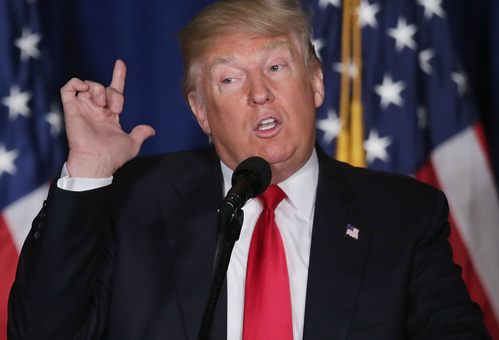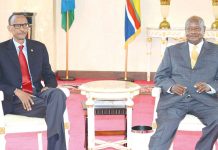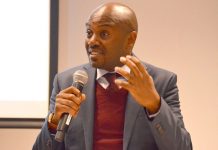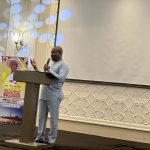For those who have closely followed the race for the presidential nominations in the Republican Party primaries in the United States of America (USA), Donald Trump’s latest foreign policy speech given on Wednesday 27th April, was a marked improvement for a candidate frequently dismissed for “being a stunts man.” Trump carried an evolution that showed a man learning the ropes of playing to the gallery of emotions and politics.
When Trump entered the race for the party nomination as an unlikely favorite, his style and utterances turned him into a favorite within a large bloc of apolitical Americans who were looking for someone and something outside of establishment politics. But within the traditional establishment in the American body politic, he presented a nightmare that had to be stopped before America sinks into an uncertain future. The pressures of that second group became intense as Trump began a winning streak of state primaries. It is then that the realities of the game sunk in and Trump has had to and will have to further transform in ways that will cover more ground and win over resistant constituencies as he tried to do with his speech.
Trump appeared to be more factual, measured, majestic, illuminating and thoughtful than ever before, although he continues to be interrupted with some contradictions. A few weeks ago, one would be very economical with the use of such adjectives to describe the billionaire businessman.
The speech provided a fresh opportunity for his domestic and foreign audience, to glance and interpret, a possible agenda a Trump presidency would assume in dealing with the world. He sounded firm, yet peaceful a balance required to allay fears about America’s future with the world. For its context, the speech had three driving and underlying factors.
First, Trump is at a decisive moment of the primary race, where some members of the top leadership of the party wary of the glaring signs of inexperience, have attempted to block his advance to nomination. Secondly, Donald Trump has caused concern within close allies of America who have taken his ‘gate-crashing’ utterances seriously. Lastly, Trump who is at the verge of winning his party’s card is aware that he could come against Hilary Clinton, a former US Secretary of State, who is known to be quite polished on foreign affairs. These three factors require of Trump to make reforms to his presentations and general policies now and in the near future to win the confidence of voters.
Scores in Trump’s speech
The strong points of the speech like its weak points are conspicuous. First of all, as a good sign, Trump was very focused on what would drive American policy during his tenure. He spoke resoundingly of “American interests” which should ideally drive any foreign policy lines of an administration in the United States. He clearly defined that interest as a commitment to eliminate a litany of threats to American security and prosperity. He gave a mix of action, resources, trade and alliances as the central pillars of his foreign policy agenda.
Trump also correctly identified radical Islam as a threat to world, and American stability although he did not properly defend his criticism of immigration as the vanguard of radical Islam, a shortcoming we shall return to shortly.
Unlike before and something he has been criticized for, Donald Trump was careful to give some facts and relevant examples to point out failings in [Barack Obama] his predecessor’s foreign policy, and which he is out to rectify. He highlighted American policy mistakes in Iraq, Egypt and Libya that fermented the rise of The Islamic State (ISIS). Trump presented good facts when discussing the situation in the North Atlantic Treaty Organization (NATO) where he says most partners have not been as committed as the US to their contributions.
Trump was also quite specific when he pointed out that a reduction in military size and expenditure not only threatens American security, but creates space for the rising powers in Russia and China. This cannot be more relevant than a time when the world has visualized Russia’s recent display of military might in Syria.
The use of facts and being more specific is a powerful addition for Trump. Facts and figures can make a speaker look more serious than he or she could actually be for a contest as serious as the one for the US presidency. The facts show that you have done your homework and you are already at work. Facts and figures could also make your audience and viewers think a lot more about your presentation although they may rarely go on to cross-check their accuracy.
It was also good that Donald Trump was structural, a positive indication that he is looking at both the big and small picture of some of the foreign policy situations that confront the United States. He for example, appropriately correlates the rise of ISIS to American intervention that weakened states like Iraq in the Middle East without a good exit and post intervention strategy. It means that he understands the need for interventions which also preserve states with strong institutional capacity to manage the period after intervention.
By treating immigration as both a domestic policy and foreign policy issue, Donald Trump intelligently presented one of the most complex nexuses any one running a government in America will encounter. While arguing that American interests included the preservation of jobs for its citizens, he double poked this by suggesting that radical Islam was sneaking into America through a lax immigration regime often justified as globalization, something he called a “false song of global populism.” He did not make irresponsible comments about immigrants that he was known for making in the past, a sign of a new found maturity.
Although Trump spent quite some time criticizing Barack Obama, as if Obama was his main opponent in the presidential race this should not be seen as accidental. To score more political points he was trying to undermine a Democratic Party president, with the obvious message being “America should vote for a Republican.” But also he is quite aware that Hilary Clinton the likely opponent he will face by virtue of her leadership at the State Department can as well be treated as the co-architect of the Obama foreign policy. His criticism of Obama should therefore be viewed as an attempt to win marks as a fixer who is coming to address the problems he is leaving behind. He adequately looped in Hilary Clinton as a main partner in an Obama-Clinton partnership that he thinks caused problems for America, making her a poor choice for the presidency.
Some contradictions
One would find some fault with Trump’s speech, for example at the point where he defended Israel but did not speak about a need to resolve the relationship problems between Israel and its neighbors, something that could account for regional stability in the Middle East. His shift in policy to become strongly pro-Israel can be one of the main things to note of his transformation. In the past Trump had said that he wanted to be neutral in the conflict between Israel and Palestine and its Arab neighbors, an unpopular position in the Republican Party.
It is also contradictory that he speaks against radical Islam, which he sees as a fundamentalist ideology, which potentially affects the stability of a peaceful and secular world; yet again he makes a strong religiously divisive stance of “protecting Christians” in the Middle East.
Trump further contradicts himself, when he unveils aspirations for an America that leads the world, yet he does not want that America to carry the burdens of the world. Leadership is often about carrying the greatest responsibility over the led. It is unlikely that America will have as much global influence if it does not meet some of the huge costs of maintaining global peace and security as it has done in the past. It will even be worse if another rising power takes over those costs and that burden.
At one moment of his speech, Donald Trump also spoke about making amends with Russia and China, yet he again calls for arm twisting China through trade pressures, for it to rein in North Korea. More interesting is Trump’s belief that China has grown economically only because of its access for its products to the American market. In the process he overlooks the role of China in growing the industrial capacity of giant American corporations, through affordable resources and a large market for products. As such he loses sight of the dichotomous and symbiotic relationships in international trade, which any American president should be careful not to mismanage.
Something else to note about the speech, is that Donald Trump finds the scope of the failings of American foreign policy to the long period after the cold war. But in his attribution of blame for these failings, he only singles out Obama and Clinton, who we can say inherited a lot of the foreign policy crises that they dealt with, from their predecessor George Bush Jr, who having been a Republican President with a similar vision of a “Great America”, is not mentioned anywhere in Trump’s speech.
There was also an attempt by Trump to fault Obama for ‘helping’ to advance radical Islam through creating conditions for the emergence of ISIS, which is just one chapter of radical Islam. If he was careful to be objective on this one, Trump should have recognized the evolutionary character of radical Islam, and recognized Obama’s role in the elimination of Osama Bin Laden, which was one of the American government’s objectives to moderate radical Islam, since the time of the Bill Clinton presidency.
It could be a mistake for Trump to look at foreign policy as monolithic glory instead of a heterogeneous partnership. Although this is a conservative position, he was expected to capture, to unite the Republican Party behind his candidature, Trump’s reference to America as a “Savior of the World” contradicts his recommendation for a collective partnership and effort between Democrats, Republicans, Independents, and allies to address universal problems.
Despite the weaknesses identified in Trump’s speech, the contradictions that stand out mostly portray that Trump is like many of the American people groping at the intersection of what is American and what is global. To manage this complex juncture, Trump besides his plans, will have to adopt a wait, see and tackle approach to whatever situations will arise out of America’s domestic and foreign affairs.
The writer is a Public Intellectual, Consultant, and Assistant Professor of Media and Communications.





















